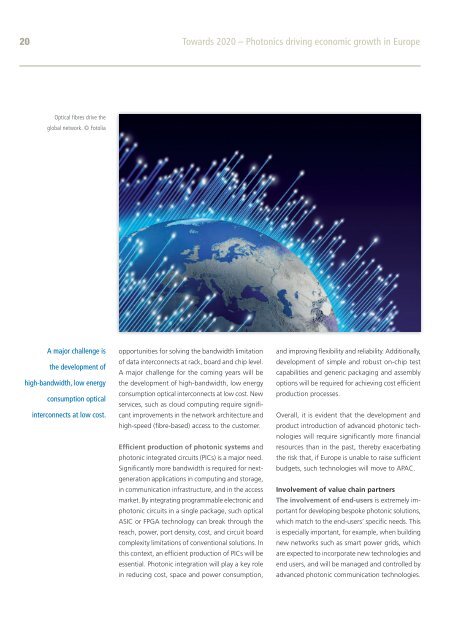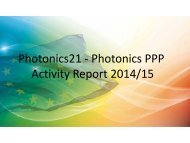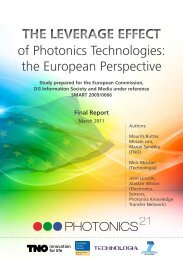Towards 2020 – Photonics driving economic growth in Europe
You also want an ePaper? Increase the reach of your titles
YUMPU automatically turns print PDFs into web optimized ePapers that Google loves.
20 <strong>Towards</strong> <strong>2020</strong> <strong>–</strong> <strong>Photonics</strong> <strong>driv<strong>in</strong>g</strong> <strong>economic</strong> <strong>growth</strong> <strong>in</strong> <strong>Europe</strong><br />
Optical fibres drive the<br />
global network. © Fotolia<br />
A major challenge is<br />
the development of<br />
high-bandwidth, low energy<br />
consumption optical<br />
<strong>in</strong>terconnects at low cost.<br />
opportunities for solv<strong>in</strong>g the bandwidth limitation<br />
of data <strong>in</strong>terconnects at rack, board and chip level.<br />
A major challenge for the com<strong>in</strong>g years will be<br />
the development of high-bandwidth, low energy<br />
consumption optical <strong>in</strong>terconnects at low cost. New<br />
services, such as cloud comput<strong>in</strong>g require significant<br />
improvements <strong>in</strong> the network architecture and<br />
high-speed (fibre-based) access to the customer.<br />
Efficient production of photonic systems and<br />
photonic <strong>in</strong>tegrated circuits (PICs) is a major need.<br />
Significantly more bandwidth is required for nextgeneration<br />
applications <strong>in</strong> comput<strong>in</strong>g and storage,<br />
<strong>in</strong> communication <strong>in</strong>frastructure, and <strong>in</strong> the access<br />
market. By <strong>in</strong>tegrat<strong>in</strong>g programmable electronic and<br />
photonic circuits <strong>in</strong> a s<strong>in</strong>gle package, such optical<br />
ASIC or FPGA technology can break through the<br />
reach, power, port density, cost, and circuit board<br />
complexity limitations of conventional solutions. In<br />
this context, an efficient production of PICs will be<br />
essential. Photonic <strong>in</strong>tegration will play a key role<br />
<strong>in</strong> reduc<strong>in</strong>g cost, space and power consumption,<br />
and improv<strong>in</strong>g flexibility and reliability. Additionally,<br />
development of simple and robust on-chip test<br />
capabilities and generic packag<strong>in</strong>g and assembly<br />
options will be required for achiev<strong>in</strong>g cost efficient<br />
production processes.<br />
Overall, it is evident that the development and<br />
product <strong>in</strong>troduction of advanced photonic technologies<br />
will require significantly more f<strong>in</strong>ancial<br />
resources than <strong>in</strong> the past, thereby exacerbat<strong>in</strong>g<br />
the risk that, if <strong>Europe</strong> is unable to raise sufficient<br />
budgets, such technologies will move to APAC.<br />
Involvement of value cha<strong>in</strong> partners<br />
The <strong>in</strong>volvement of end-users is extremely important<br />
for develop<strong>in</strong>g bespoke photonic solutions,<br />
which match to the end-users’ specific needs. This<br />
is especially important, for example, when build<strong>in</strong>g<br />
new networks such as smart power grids, which<br />
are expected to <strong>in</strong>corporate new technologies and<br />
end users, and will be managed and controlled by<br />
advanced photonic communication technologies.






